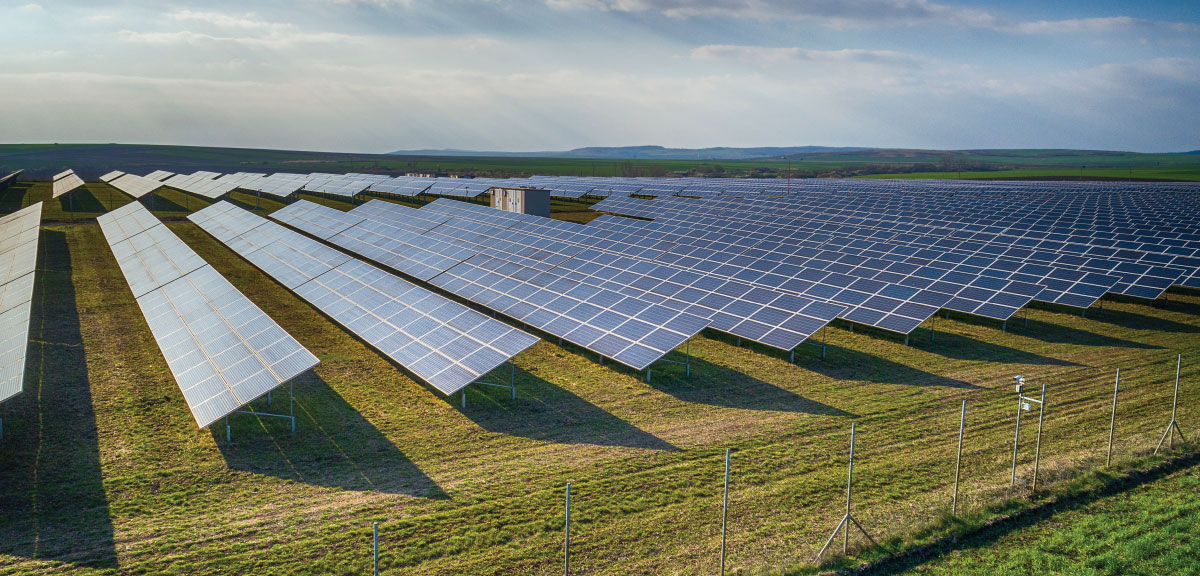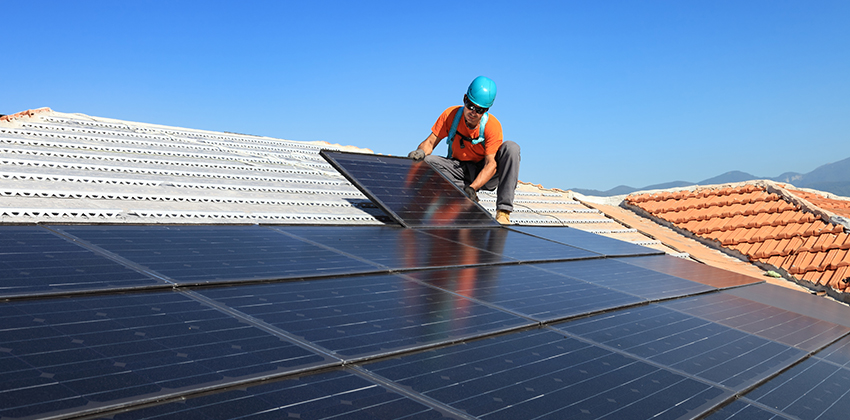How Residential Solar Installation Leads to Energy Security
Exploring the Various Types of Solar Panels and Their Distinct Benefits
The landscape of solar panels offers various options, each with distinctive benefits fit to various applications. Monocrystalline panels stand apart for their performance and appearances, while polycrystalline versions interest budget-conscious consumers. Thin-film modern technology supplies adaptability in installment. Cutting-edge layouts like bifacial and building-integrated photovoltaics further boost the charm of solar power. Recognizing these differences is necessary for making notified choices. The concern remains: which kind will best satisfy specific energy demands?
Monocrystalline Solar Panels
Although numerous sorts of solar panels are readily available, monocrystalline solar panels are typically related to as one of the most reliable alternative. These panels are made from a solitary crystal structure, commonly silicon, which permits them to convert sunlight right into power a lot more successfully than other kinds. The performance prices for monocrystalline panels can vary from 15% to over 22%, making them a prominent choice for domestic and industrial installations where room is restricted.

Polycrystalline Solar Panels
Polycrystalline solar panels are generated utilizing an unique manufacturing procedure that entails melting numerous silicon crystals together. This technique can cause benefits such as lower manufacturing costs, making them a popular choice for many customers. Their performance and efficiency variables may vary compared to other kinds of solar panels, necessitating mindful consideration.
Production Process Advantages
The manufacturing procedure of polycrystalline solar panels offers several benefits that add to their allure in the renewable energy field. The production utilizes silicon scrap, which minimizes waste and decreases material expenses, making it economically viable. Unlike monocrystalline panels, the manufacturing of polycrystalline panels entails easier and much less energy-intensive techniques, resulting in a smaller sized carbon impact. Additionally, the spreading process enables the creation of multiple cells at the same time, enhancing performance in production. This method additionally causes a more consistent structure, which can improve the overall performance and durability of the panels. Polycrystalline solar panels provide an affordable option for consumers while promoting sustainable manufacturing techniques within the sector.
Effectiveness and Performance Variables
Just how do effectiveness and performance factors influence the effectiveness of polycrystalline photovoltaic panels? These panels commonly show lower effectiveness rates, averaging around 15-20%, contrasted to their monocrystalline counterparts. Variables such as temperature sensitivity, shielding, and the angle of installation considerably impact their performance. Polycrystalline panels often tend to carry out much better in cooler environments but might struggle in high temperature levels, causing decreased outcome. Furthermore, their performance can be influenced by dust and debris build-up, demanding routine upkeep. Regardless of these difficulties, polycrystalline panels are extra affordable and provide a solid equilibrium in between expense and performance. Comprehending these effectiveness and efficiency variables is important for consumers looking for to take full advantage of solar power manufacturing and general system performance.
Thin-Film Solar Panels
Thin-film solar panels stand for a lightweight and versatile option in the solar power landscape. These panels are constructed by transferring several thin layers of photovoltaic or pv product onto a substrate, which can include metal, plastic, or glass. This manufacturing procedure enables greater versatility in style and applications contrasted to typical crystalline photovoltaic panels.
Thin-film technology usually includes reduced effectiveness prices, yet it makes up for this with decreased manufacturing prices and improved efficiency in low-light problems. Their lightweight nature makes them ideal for installation on varied surface areas, including curved structures and vehicles. In addition, these panels can be incorporated into structure products, using aesthetic benefits alongside power generation.
Bifacial Solar Panels
Bifacial solar panels are obtaining focus for their boosted effectiveness and efficiency, as they can catch sunlight from both sides. This dual-sided design permits boosted power production, especially in reflective environments. Additionally, their installation uses possible price advantages, making them an eye-catching option for different applications.
Efficiency and Performance
The efficiency and efficiency of solar panels are vital consider establishing their performance in power generation, with bifacial solar panels sticking out for their cutting-edge design. These panels feature photovoltaic or pv cells on both sides, allowing them to capture sunshine from several angles. This dual-sided capability improves power output, specifically in environments with reflective surface areas, such as snow or sand. Bifacial solar panels can boost power production by 10-20% contrasted to typical monofacial panels. Their capability to harness indirect sunlight adds to their total efficiency, making them an engaging selection for different applications. In addition, innovations in modern technology proceed to improve their efficiency metrics, strengthening their place in the renewable resource landscape as a very efficient service for solar energy generation.
installation and Expense Advantages
When thinking about the benefits of bifacial photovoltaic panels, the installation procedure and price benefits are substantial variables that can affect decision-making for both residential and business applications. Bifacial panels can be installed Learn More Here on different frameworks, consisting of rooftops and ground installations, permitting for functional deployment. Their capacity to take in sunlight from both sides boosts power generation without requiring additional panels. This efficiency can lead to decreased overall installation prices, as fewer units might be required to achieve desired energy outputs. Additionally, their resilience often translates to reduce upkeep expenses gradually (Solar Installation). Consequently, the lasting monetary benefits, incorporated with installation versatility, make bifacial solar panels an appealing selection for those looking for sustainable power solutions
Building-Integrated Photovoltaics (BIPV)
Building-Integrated Photovoltaics (BIPV) stand for a considerable development in solar modern technology, effortlessly including solar batteries right into building materials such as roofing systems, home windows, and facades. This ingenious technique not just creates renewable resource but additionally improves the appearances and performance of buildings. BIPV systems can replace conventional building products, lowering the general price of building and construction while adding to energy effectiveness.
The integration of solar innovation right into architectural layout permits much better space use, as these systems can be set up without calling for added land. Furthermore, BIPV options are adjustable, making it possible for architects to develop one-of-a-kind designs that match the building's general appearance. The double capability of BIPV-- serving both as a power generator and a structural component-- supplies significant advantages in urban atmospheres where area is restricted. As understanding of lasting building practices expands, BIPV is coming to be a progressively eye-catching option for programmers and house owners alike.
Concentrated Photovoltaic (CPV) Systems
Concentrated Photovoltaic (CPV) systems represent an innovative solar technology that mirrors or uses lenses to concentrate sunlight onto high-efficiency solar cells. This ingenious approach permits the collection of significantly even more solar power than traditional photovoltaic or pv systems. By concentrating sunlight, CPV systems can achieve higher performances, commonly surpassing 40%, making them particularly ideal for locations with high direct sunshine.
Additionally, CPV systems usually need less acreage compared to traditional solar panels, as they generate even more power from a smaller sized impact. These systems typically incorporate tracking devices that readjust the position of the lenses or mirrors to adhere to the sun's motion, making best use of energy capture throughout the day. However, CPV modern technology is best suited for specific geographical places, where straight sunshine is plentiful, restricting its applicability in areas with frequent cloud cover. Generally, CPV systems provide This Site a promising choice for enhancing solar power production in ideal atmospheres
Contrast of Solar Panel Effectiveness and Expense
Although different solar panel technologies exist, their performance and price can substantially differ, influencing customer options and market characteristics. One of the most typical kinds-- polycrystalline, monocrystalline, and thin-film-- exhibit distinctive attributes in efficiency and rates. Monocrystalline panels tend to use the greatest effectiveness rates, frequently exceeding 20%, but they typically include a higher price. On the other hand, polycrystalline panels are usually more cost effective, with efficiencies around 15-20%, making them a prominent choice for budget-conscious customers. Thin-film innovations, while less reliable at around 10-12%, offer versatility and lower installation expenses, appealing to details applications.
Ultimately, choosing the ideal photovoltaic panel includes weighing the balance between effectiveness and cost. Consumers need to consider their power needs, spending plan constraints, and long-term financial savings possibility, as these elements will determine the finest selection for their solar power system.
Regularly Asked Inquiries
How Long Do Solar Panels Usually Last Prior To Needing Substitute?
Solar panels typically last in between 25 to thirty years before requiring substitute. Their resilience relies on numerous factors, including high quality, setup, and local ecological problems, which can affect their effectiveness and longevity with time.

Can Solar Panels Work in Cloudy or Rainy Conditions?
Solar panels can without a doubt operate in stormy or over cast conditions, albeit at reduced efficiency. They still catch diffuse sunshine, permitting energy generation, though energy output might be significantly reduced than on bright days.
What Upkeep Is Needed for Solar Panels?
Regular maintenance for solar panels includes regular cleansing to get rid of dirt and debris, inspecting for damages, ensuring links are safe, and evaluating system efficiency. Normal check-ups can enhance performance and extend the lifespan of the panels.
Are There Any Environmental Effects From Production Solar Panels?
Yes, producing solar panels can have ecological impacts, including resource extraction, power consumption, and waste generation. Improvements in technology aim to decrease these results, advertising even more sustainable methods in manufacturing and reusing procedures.
Exactly how Do I Select the Right Photovoltaic Panel for My Home?

Various types of solar panels are offered, monocrystalline solar panels are usually related to as the most reliable choice. Thin-film solar panels represent a versatile and lightweight option in the solar energy landscape. The effectiveness and efficiency of solar panels are crucial factors in determining their efficiency in energy generation, with bifacial solar blog panels standing out for their cutting-edge design. Building-Integrated Photovoltaics (BIPV)
Building-Integrated Photovoltaics (BIPV) represent a stand for evolution considerable advancement technology, innovation incorporating effortlessly cells into building right into such as roofs, roofings, and facades. Concentrated Photovoltaic (CPV) systems stand for an advanced solar modern technology that mirrors or makes use of lenses to concentrate sunshine onto high-efficiency solar cells.